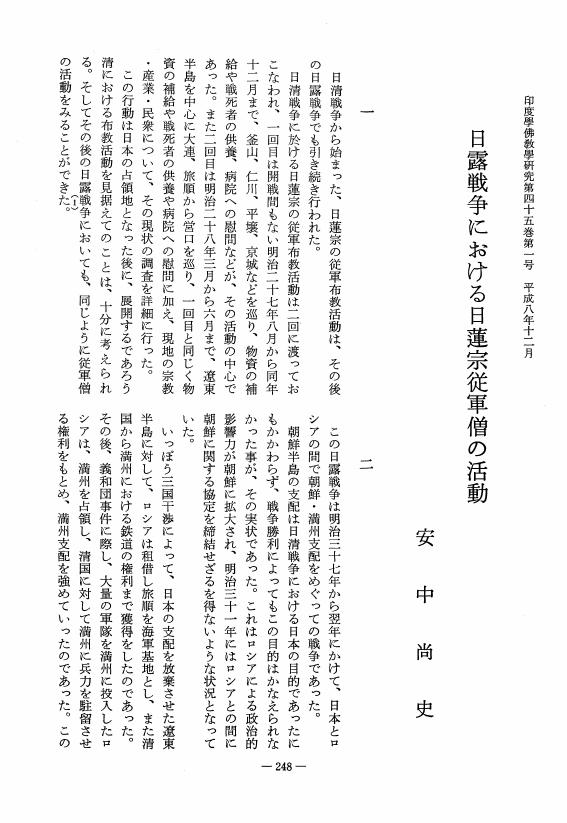2 0 0 0 OA 浄厳の「大日経疏」解釈について
- 著者
- 上田 霊城
- 出版者
- Japanese Association of Indian and Buddhist Studies
- 雑誌
- 印度學佛教學研究 (ISSN:00194344)
- 巻号頁・発行日
- vol.23, no.1, pp.301-304, 1974-12-25 (Released:2010-03-09)
2 0 0 0 OA 幻化網タントラにおける灌頂
- 著者
- 木村 秀明
- 出版者
- JAPANESE ASSOCIATION OF INDIAN AND BUDDHIST STUDIES
- 雑誌
- 印度學佛教學研究 (ISSN:00194344)
- 巻号頁・発行日
- vol.39, no.2, pp.861-859, 1991-03-20 (Released:2010-03-09)
2 0 0 0 OA 四分律の〓度成立に關する一考察-特に波羅夷學悔の規定をめぐって-
- 著者
- Shayne CLARKE
- 出版者
- Japanese Association of Indian and Buddhist Studies
- 雑誌
- 印度學佛教學研究 (ISSN:00194344)
- 巻号頁・発行日
- vol.49, no.2, pp.923-921, 2001-03-20 (Released:2010-03-09)
2 0 0 0 OA 新羅元暁の遊心安楽道は偽作か
- 著者
- 恵谷 隆戒
- 出版者
- JAPANESE ASSOCIATION OF INDIAN AND BUDDHIST STUDIES
- 雑誌
- 印度學佛教學研究 (ISSN:00194344)
- 巻号頁・発行日
- vol.23, no.1, pp.16-23, 1974-12-25 (Released:2010-03-09)
2 0 0 0 新羅元暁の遊心安楽道は偽作か
- 著者
- 恵谷 隆戒
- 出版者
- JAPANESE ASSOCIATION OF INDIAN AND BUDDHIST STUDIES
- 雑誌
- 印度學佛教學研究 (ISSN:00194344)
- 巻号頁・発行日
- vol.23, no.1, pp.16-23, 1974
2 0 0 0 OA 聖光院澄尋についての一考察
- 著者
- 窪田 哲正
- 出版者
- Japanese Association of Indian and Buddhist Studies
- 雑誌
- 印度學佛教學研究 (ISSN:00194344)
- 巻号頁・発行日
- vol.40, no.1, pp.171-176, 1991-12-20 (Released:2010-03-09)
2 0 0 0 悲華経の檀波羅蜜行について
- 著者
- 宇治谷 祐顕
- 出版者
- JAPANESE ASSOCIATION OF INDIAN AND BUDDHIST STUDIES
- 雑誌
- 印度學佛教學研究 (ISSN:00194344)
- 巻号頁・発行日
- vol.20, no.1, pp.71-75, 1971
2 0 0 0 OA 洞山五位説と異類中行の問題
- 著者
- 兪 炳根
- 出版者
- Japanese Association of Indian and Buddhist Studies
- 雑誌
- 印度學佛教學研究 (ISSN:00194344)
- 巻号頁・発行日
- vol.52, no.2, pp.651-653, 2004-03-20 (Released:2010-03-09)
2 0 0 0 OA インド仏教研究へのイスラーム史料の可能性
- 著者
- 保坂 俊司
- 出版者
- Japanese Association of Indian and Buddhist Studies
- 雑誌
- 印度學佛教學研究 (ISSN:00194344)
- 巻号頁・発行日
- vol.41, no.1, pp.36-38, 1992-12-20 (Released:2010-03-09)
2 0 0 0 フゥランテプテル研究序説
- 著者
- 稻葉 正就
- 出版者
- JAPANESE ASSOCIATION OF INDIAN AND BUDDHIST STUDIES
- 雑誌
- 印度學佛教學研究 (ISSN:00194344)
- 巻号頁・発行日
- vol.13, no.1, pp.1-10, 1965
2 0 0 0 OA 日露戦争における日蓮宗従軍僧の活動
- 著者
- 安中 尚史
- 出版者
- Japanese Association of Indian and Buddhist Studies
- 雑誌
- 印度學佛教學研究 (ISSN:00194344)
- 巻号頁・発行日
- vol.45, no.1, pp.248-252, 1996-12-20 (Released:2010-03-09)
- 被引用文献数
- 1
2 0 0 0 OA 源信撰『阿弥陀経略記』の無量寿三諦説について
- 著者
- 小山 昌純
- 出版者
- JAPANESE ASSOCIATION OF INDIAN AND BUDDHIST STUDIES
- 雑誌
- 印度學佛教學研究 (ISSN:00194344)
- 巻号頁・発行日
- vol.51, no.1, pp.103-105, 2002-12-20 (Released:2010-03-09)
2 0 0 0 OA カマラシーラの因果論
- 著者
- 人見 牧生
- 出版者
- JAPANESE ASSOCIATION OF INDIAN AND BUDDHIST STUDIES
- 雑誌
- 印度學佛教學研究 (ISSN:00194344)
- 巻号頁・発行日
- vol.55, no.1, pp.441-438,1227, 2006-12-20 (Released:2010-07-01)
In the Karmaphalasambandhapariksa of the Tattvasamgrahapañjika, Kamalasila constructed his causal theory. In this paper, I focus on four points: Causal relations between two moments, Rules which governs causes, Mutual actions between cause and effect, Rules which governs effects. the outstanding characteristic of his causal theory is that he added two niyamas to limit the causal relations, i. e. one that limits causes and another that limits effects. The former is called “karanasaktiniyama,” which means limitation of the capacity of a cause to create an effect. The later is called “anantaryaniyama” which means that an effect originates immediately after a particular cause is in place. This is equal to the action, apeksa, which is the function of an effect on a cause. Thus, by adding these niyamas, Kamalasila understood causal relation in terms of “effect originates when particular cause exists” and “effect does not originate when particular cause exists” In this paper, I focus on these two niyamas, considering one aspect of his interpretation of pratitya-samutpada. In fact, his causal theory constructed in this chapter of TSP corresponds to the definition of pratitya-samutpada and dharmaniyamata in Kamalasila's Aryasalistambakatika. Thus, it can be pointed out that he interprets one aspect of pratitya-samutpada as “karyakaranabhava-pratiniyama.”
2 0 0 0 OA 道元禅師における皮肉骨髄について
- 著者
- 晴山 俊英
- 出版者
- JAPANESE ASSOCIATION OF INDIAN AND BUDDHIST STUDIES
- 雑誌
- 印度學佛教學研究 (ISSN:00194344)
- 巻号頁・発行日
- vol.46, no.1, pp.91-94, 1997-12-20 (Released:2010-03-09)
2 0 0 0 OA 明治維新期における廃仏棄釈の一断面-富山藩の場合-
- 著者
- 北沢 俊嶺
- 出版者
- JAPANESE ASSOCIATION OF INDIAN AND BUDDHIST STUDIES
- 雑誌
- 印度學佛教學研究 (ISSN:00194344)
- 巻号頁・発行日
- vol.19, no.2, pp.647-648, 1971-03-31 (Released:2010-03-09)
2 0 0 0 OA 鎮西教学に於ける浄土法門の顕彰
- 著者
- 後藤 尚孝
- 出版者
- JAPANESE ASSOCIATION OF INDIAN AND BUDDHIST STUDIES
- 雑誌
- 印度學佛教學研究 (ISSN:00194344)
- 巻号頁・発行日
- vol.23, no.2, pp.631-632, 1975-03-31 (Released:2010-03-09)
2 0 0 0 OA ヒンディー語における過去時制の対立
- 著者
- 溝上 富夫
- 出版者
- JAPANESE ASSOCIATION OF INDIAN AND BUDDHIST STUDIES
- 雑誌
- 印度學佛教學研究 (ISSN:00194344)
- 巻号頁・発行日
- vol.19, no.2, pp.880-883, 1971-03-31 (Released:2010-03-09)
2 0 0 0 法華經に現われた布施行について
- 著者
- 上田 本昌
- 出版者
- JAPANESE ASSOCIATION OF INDIAN AND BUDDHIST STUDIES
- 雑誌
- 印度學佛教學研究 (ISSN:00194344)
- 巻号頁・発行日
- vol.8, no.1, pp.292-295, 1960
2 0 0 0 唐貞観中の遺教経施行について
- 著者
- 滋野井 恬
- 出版者
- JAPANESE ASSOCIATION OF INDIAN AND BUDDHIST STUDIES
- 雑誌
- 印度學佛教學研究 (ISSN:00194344)
- 巻号頁・発行日
- vol.26, no.1, pp.280-283, 1977
2 0 0 0 華厳経における捨と施についての考察
- 著者
- 陳永裕(本覚)
- 出版者
- JAPANESE ASSOCIATION OF INDIAN AND BUDDHIST STUDIES
- 雑誌
- 印度學佛教學研究 (ISSN:00194344)
- 巻号頁・発行日
- vol.51, no.2, pp.841-838, 2003












